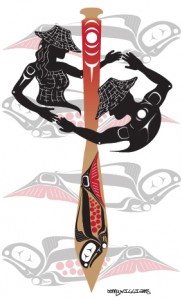Gift of Cedar – This is an explanation about the meaning of the gift, a request for institutions to identify what area they want to be in, any updates on the tree’s growth, and photos (planting, growth, etc).
Coast Salish peoples have a creation story that explains the origins of Cedar. According to the story, there once lived a good man who always gave away his belongings and food to others. The Creator recognized the man’s kindness, and declared that once the man dies, a Red Cedar tree will grow where he is buried, and the tree will continue to help the people.1 The Nuu-chah-nulth of Vancouver Island have a similar origin story for Yellow Cedar. According to their stories, Yellow Cedar trees were transformed from three young women running up a mountain. Therefore, Yellow Cedar trees are found on the slopes of subalpine mountains, and contain soft inner bark, like that of woman’s hair.2
1 Hilary Stewart, Cedar (Vancouver: Douglas and McIntyre: 1984), 27.
2Stewart, 27
http://indigenousfoundations.arts.ubc.ca/home/culture/cedar.html
S‘i:wes
The man and woman are in a circle to represent the circle of life: the left hands are open to represent receiving, and right hands are open in down positions to represent giving. Their heads are down representing humbleness to each other. The cedar hats and cedar clothing represents Stó:lō culture and signifies the importance of cedar to our people. The paddle represents the journey of our First Nation people. The salmon on the paddle represents the river. The Stó-ló are the people of the river. The male and femaile salmon in the background also show the circle of life as salmon are the Stó-lō people’s main source of food.
About the Artist
Jonathan (Jonny) Williams is Stó:lō from the Chiyó:m (Cheam) First Nation. He grew up in Chilliwack, BC. Jonny is a self-taught artist. Through many years of practice, Jonny has developed his own style of First Nation art.
Check back for updates, coming soon.


